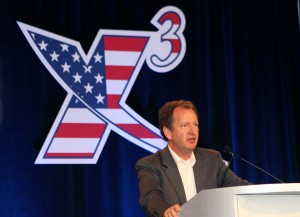2012-07-16 By Robbin Laird
The month long visit of the X3 – high-speed hybrid Eurocopter to America is half-way overview.
It began at the Eurocopter facilities in Grand Prairie, Texas in June 2012. With the Lt Governor of Texas and other political dignitaries present, the senior leadership of Eurocopter introduced the X 3 to the United States.
The Lt. Governor who praised the contribution of Eurocopter to the Texas and American economy. He highlighted the pro-growth policy of the state and noted that Texas was the national leader in new job creation for the past few years. He also added that “The potential for this aircraft to help the state of Texas in homeland security and emergency services is so obvious.”

(Among dignitaries at the event was Lt. Gov. David Dewhurst. “The potential for this aircraft to help the state of Texas in homeland security and emergency services is so obvious,” he said.
http://www.star-telegram.com/2012/06/20/4047925/aviation.html).
For the Eurocopter team, this was a chance to highlight their experimental, proof of concept hybrid helicopter.
This helo is a hybrid of turboprop plane and a traditional rotorcraft. It has the stability of the turboprop with the flexibility of a helicopter.
And in the flight demonstration, the hybrid clearly showed the significant stability, mobility and speed, which it brings to the table for various customers. It is a test aircraft, and it remains to be seen how the concept will be applied to a production aircraft and how it will be sized for the market.
Currently, the test aircraft is using a Dauphin airframe with NH-90 engines in addition to the turboprops.
But Eurocopter might well look to a larger airframe for the production model
The helicopter is designed to provide a low cost high-speed operating form factor while ensuring the versatility and functionalities of a helicopter, such as VTOL, hovering, autorotation.
It is aimed at customers who use rotorcraft for various missions where speed or mission duration is of the essence and therefore who could use higher speed to provide better solutions to their core missions.
And it aims at “affordable” high speed, by which Eurocopter sees mission costs reduced by the rotorcraft using both rotor blades and turbo props to gain efficiencies.
And by building from a technical architecture extremely simple and close to classic helicopter platforms, Eurocopter is very confident it can provide limited increase of the production costs of the product.
How does an X3 work?
The X3 can change the speed of its main rotor in flight, avoiding drag divergence on the advancing blade and increasing the stall speed of the retreating blade, while also reducing noise. The small stub wings unload the main rotor at speed, thus allowing for the reduced main rotor rpm.
I interviewed one of the test pilots at last year’s Paris air show.
This was just about a year ago, so I was able to get an update from him after the flight in Texas. Hervé Jammayrac explained at that time how the helo works.
This aircraft is a helicopter. And that, I think, is the key point for us.
Then we wanted to go faster. How can we go faster?
We are limited on a conventional helicopter because you have to tilt the rotor, and you have also the problem of an advancing blade that becomes trans sonic. So to overcome these two problems, the idea is to fly level. Zero incidents, flat pitch so you have a reduced drag, and then the propulsion.
You need to bring the propulsion in another way, so that’s why we have installed these two propellers in order to be able to create this forward thrust. That’s the general principle.
In order to accelerate, because of this advancing blade becoming trans sonic we have to reduce the rotor speed. Since we reduce rotor speed, we lose some lift, and then that’s where we have the wings that come into play and the wings are going to get, let’s say, about 40 percent of the lift at cruise speed; forty percent of the lift at cruise speed is provided by the wings.
Everything is linked together. You have the main gearbox.
We have the two engines that are running the main gearbox, and then you have the two propellers that are also connected to the gearbox.
Imagine, for example, on a conventional helicopter, you have the tail rotor, you have a shaft connecting to the tail, so we have removed this, and we have put it on the side, and we have both of them.
Overall, we are able to do some anti-torque with differential pitch on the propellers, and the same controls are also giving us the thrust in forward flight.
https://sldinfo.com/an-update-on-the-x3-a-conversation-with-herve-jammayrac/
At the launch ceremony, Jammayrac provided an update of developments for the past year.
We have finished the proof of concept. It works. Much of my time this year has been developing data to help determine the form factor for such a system. The next step is clearly to design a production aircraft and our work over the past year has been to provide inputs to such a decision.
I also asked him if he thought this hybrid might solve some of the problems seen by helos in Afghanistan in operating in higher altitudes.
“It definitely has much greater capability to operate at higher altitudes than a traditional helicopter. It might well be able to more effective in such an operational setting.”
Why High Speed?
After the ceremonies and the festivities, I was able to sit down one on one with the CEO and President of Eurocopter, Lutz Bertling, to discuss the potential uses of a production version of the X3.
He clearly did not want to commit himself to what the production version might look like, but I suspect that it might not be a single helo but perhaps even a family of helos empowered by the X3 concept.
I put the question directly to him:
What is the use of a high speed helicopter in the market of today and tomorrow?

Bertling identified 4 key markets for such a product. He saw a combination of markets ranging from the commercial to the military.
First, “there is a significant potential for its use in the commuter travel market. Currently, there is higher demand than there are commercial slots at airports. With a high speed helicopter which can cover ranges up to or perhaps more than 200 miles, this product can open up possibilities for commercial travel,”
Second, “there clearly is a market in the oil and gas industry. One can already identify the locations for future oil and gas platforms and they are much further out than current realities. The Arctic is a key driver as well for the need for the range and speed which the helicopter can provide.”
Third, “there are clear requirements in the security field where speed and range matters. For example, the USCG operating in the Pacific could find this to be a core capability. They clearly will not by an Osprey or operate them off of their national security cutters. This product will be affordable and maintainable, key requirements for the USCG.”
Fourth, “there are clearly opportunities in the military market where speed, range, and cost effectiveness matter. Search and rescue, emergency air lift, combat support and perhaps things like providing escorts for the USMC Ospreys might be on offer.”
Bertling underscored that three things needed to come together to make this a product which can re-shape the marketplace.
- The plane needs to be affordable. He estimates that the production version will cost 25% more than a traditional helicopter.
- It needs to be fast, and this helo will be about 50% faster than traditional helicopters (operating at 220 knots versus 130-140 knots).
- It needs to be maintainable, and the relative simplicity of the helo will make it so.
“That is why for me, the X3 is introducing a new approach to productivity, and should not be simply characterized by high speed. The helo allows one to go faster, with effective range, and fuel efficiencies.”
And on the nature of the Arctic challenge within which X 3 will make excellent operational sense see
https://sldinfo.com/a-danish-perspective-on-the-challenge-of-arctic-security/
https://sldinfo.com/empowering-an-arctic-strategy/
The Impact of High Speed
We have already seen with the Osprey the impact of high speed and range for operations In operations off of Libya, the ability of the USMC to connect Sigonella with the USS Kearsarge rapidly allowed for a significant increase in combat capability.
https://sldinfo.com/the-role-of-the-osprey-in-operation-odyssey-dawn/
In Bold Alligator, the importance of ship to ship as well as ship to shore operations from the Osprey also demonstrated the sea change, which speed and range can bring.
The potential advantage, which the X3 brings to the party, is its potential commercial foundation.
Eurocopter has been very successful in supporting the oil and gas industry, and X3 is a natural for this market space now and in the future.
Success in this domain alone will guarantee production helicopters.
The USCG could well be a core client as well. Not only have they used the Dauphin as their core helicopter for a number of years, but the pressure on ship numbers ensures the need to get better coverage from those ships which are built and deployed. Reach and range would be facilitated by the X3 or X3 family of helos.
For a look at the challenges facing the USCG in the Pacific see
https://sldinfo.com/the-uscg-in-the-pacific/
and
This then would allow the military and security services to have a capable hybrid helo available to provide for a variety of missions where the speed and range of the X3 could be significant.
The Osprey has demonstrated the need and impact and ironically, the two together could be game changers for allies and the U.S. military as well.
And of course there is a very simple way that the X3 production helo might enter into a support role for the US military.
The Military Sealift Command uses Pumas via the leasing companies which support MSC and through MSC, the worldwide deployments of the USMC and USN team. It is very likely if the X3 has commercial success with the oil and gas industry or becomes a success in the commuter aviation sector, that the leasing companies would latch on to the X3 production helo or family of helos as a very useful capability to support the globally deployed US seabases.
For a look at Pumas and the Military Sealift Command see
https://sldinfo.com/sustaining-a-forward-presence-the-military-sealift-command/
https://sldinfo.com/tak-ing-the-supply-ship-to-a-whole-other-level/
https://sldinfo.com/pumas-in-support-of-the-us-fleet-global-operations/
https://sldinfo.com/pumas-at-bold-alligator-2012/
For related X 3 Videos and a Slideshow
https://sldinfo.com/what-is-the-x-cubed/
https://sldinfo.com/x-3-video-the-hybrid-helicopter-starts-its-american-tour/
An earlier version of this piece appeared on AOL Defense.
http://defense.aol.com/2012/07/06/high-speed-high-value-the-x3-hybrid-helo-demos-at-huntsville/

